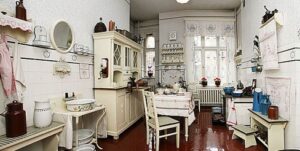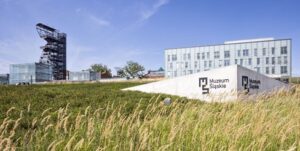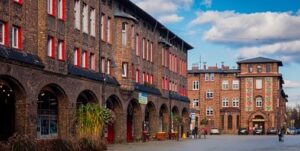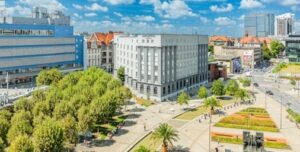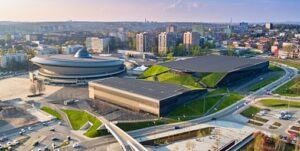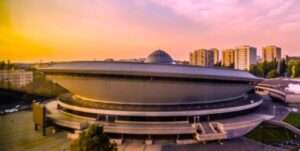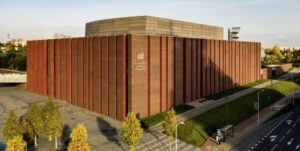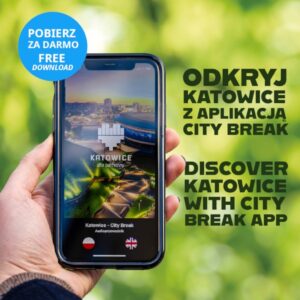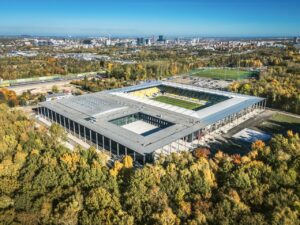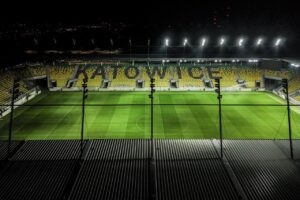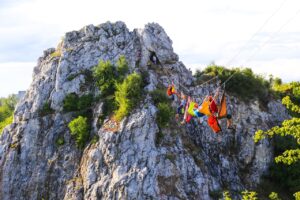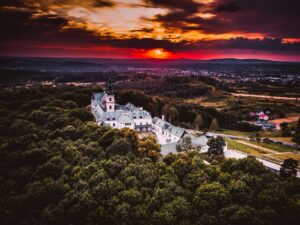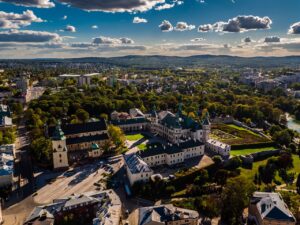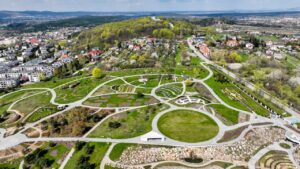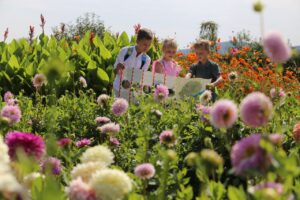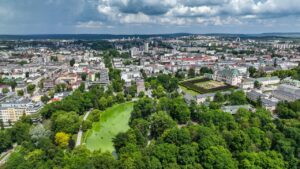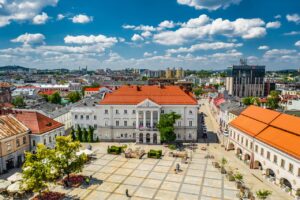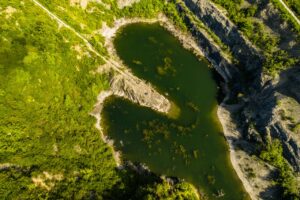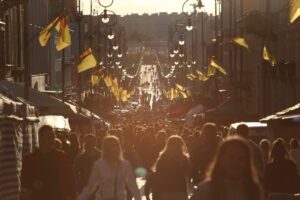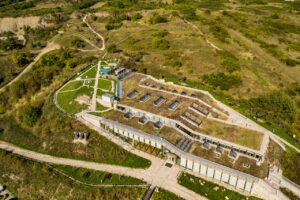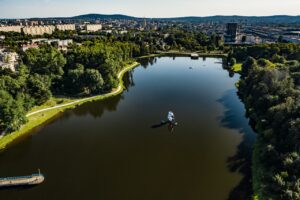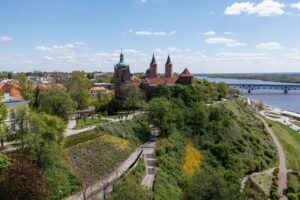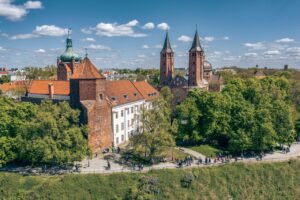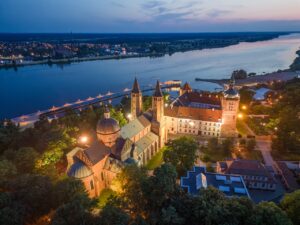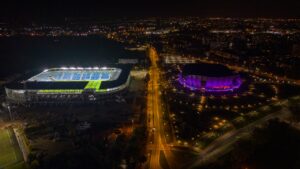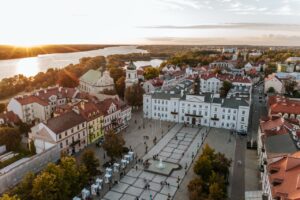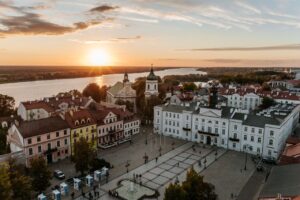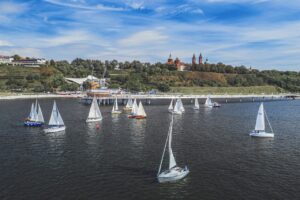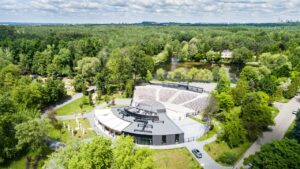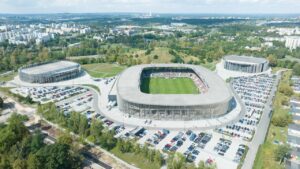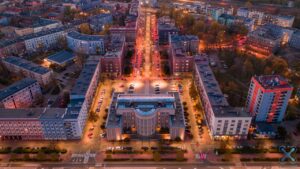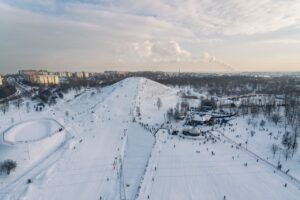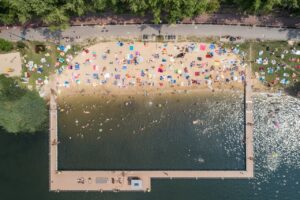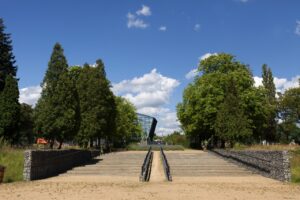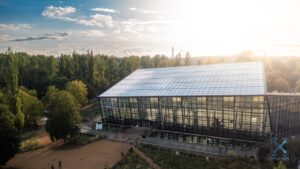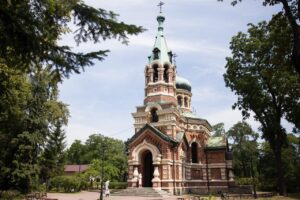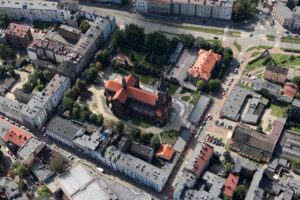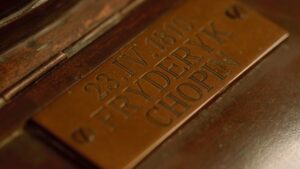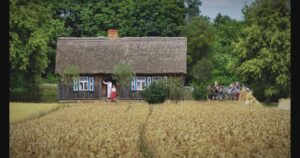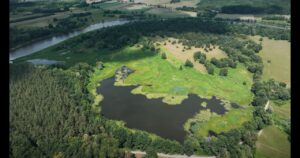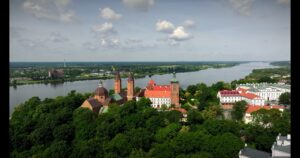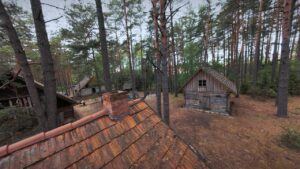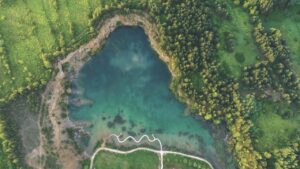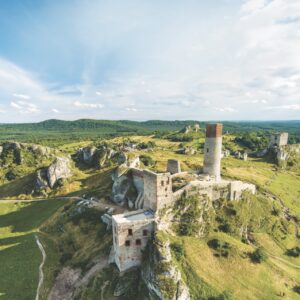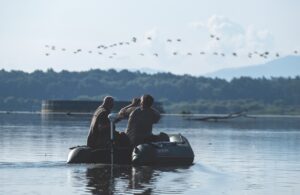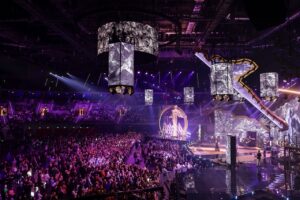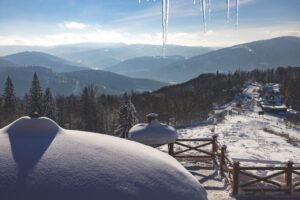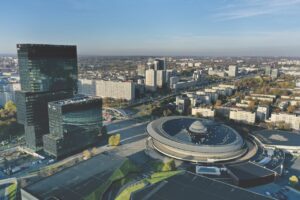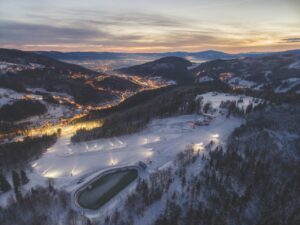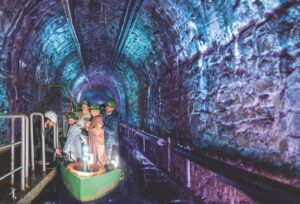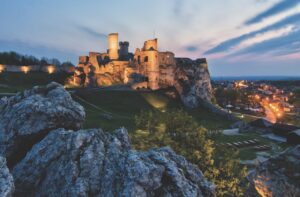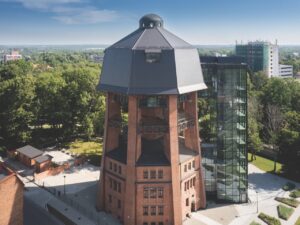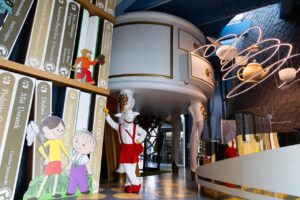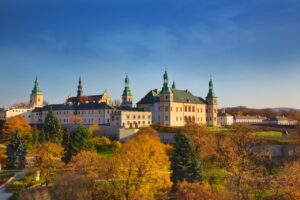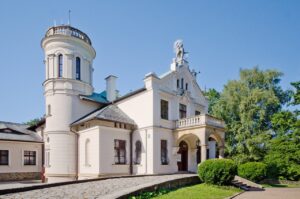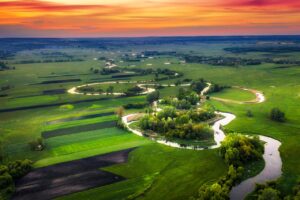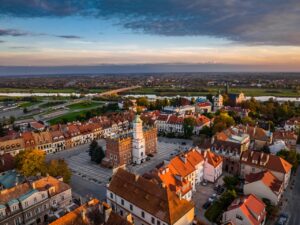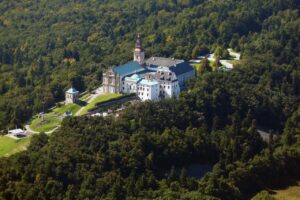Host
Katowice
Katowice, located in the southern part of Poland, is the capital of the country’s first metropolis. It consists of 41 cities, with more than 2.5 million people.
Katowice is a well-connected city, near which the A1 and A4 highways intersect, allowing travel in all directions across Europe. Some of the cities in the metropolis are connected by the controlled-access highway named Drogowa Trasa Średnicowa, which runs through the center of Katowice, and the dense network of railway lines makes it possible to comfortably reach Prague, Vienna, Budapest, or Berlin in just a few hours. Located about 30 km north of the center of Katowice, in Pyrzowice, Katowice International Airport is one of the largest and most dynamically developing airports in the country. Moreover, within a 100 km radius, there are two other international airports – in Krakow and Czech Ostrava.
In Katowice music has long taken a special place. This very important aspect of culture in 2015 was appreciated by UNESCO, awarding Katowice the title of a creative city in the field of music. Katowice also has a huge share in the phenomenon of the Silesian blues.
Tourists visiting Katowice and our residents can take advantage of the new app – City Break, which after downloading to mobile devices will guide you through the most important tourist attractions of Katowice.
It allows you to get to know, among other things, selected works of Street Art, functionalist architecture on the Modernism Route, or to get involved in the post-industrial climate of the magical Nikiszowiec.
There is also no shortage of Katowice Beboks – users of the app are encouraged to have fun by exploring the urban space on the occasion of searching for these sympathetic creatures.
In addition to the standard audio guide function, users can also take part in quizzes to test their knowledge of the attractions they have visited.
The app is available free of charge on Android and iOS devices.
The advantage of Katowice is its well-developed IT infrastructure and research and development sector. Katowice are a leader in the field of innovation and new technologies. They are also among the leading Polish cities that focus on the development of modern business sectors, including the regional office market, along with the modern office services industry.
The business tourism market is also something on which the City of Katowice is currently building its potential. Thanks to the excellent conference and hotel facilities, as well as the reputation that the city has gained after the organization of international events, often under the auspices of the UN (COP24, PRECOP, IGF2021, WUF11), interest in Katowice is huge.
This is where major business events take place, such as the European Economic Congress, the European Congress of Small and Medium-sized Enterprises or annual meetings of doctors of various scientific disciplines. The program of events does not lack concerts and cultural performances, as well as sports competitions attracting crowds of fans, including e-sport fans who visit the annual Intel Extreme Masters finals in great numbers.
Katowice, calling themselves a city for a change, still hides many secrets. The best guides to the city’s unconventional attractions and corners are the local residents, who are the best ambassadors of Katowice and its greatest asset. The engagement of the residents of Katowice activates changes in the city’s space, making the capital of the Silesian Voivodeship one of the fastest-growing cities in Poland.
Kielce
Kielce is the capital of the Świętokrzyskie Voivodeship and one of the regions of the European Union, a city located in the Świętokrzyskie Mountains with attractive landscape values, an economic, academic, cultural, sports and tourist center. Kielce is located only 180 kilometers from Warsaw and 120 kilometers from Krakow.
Kielce is located in the historically and naturally unique area of the Holy Cross Mountains Geopark, which in 2021 was included in the UNESCO World Geoparks Network list. Often called “the biggest open-air museum of geology,” it has 5 nature reserves within their brders, the most impressive of which is Kadzielnia – a former quarry with Poland’s most beautiful amphitheater built into the rocks, as well as caves, a waterfall, a winter icefall and a zip line. This, along with the modern Geoeducation Center on Wietrznia and the Botanical Garden on the slope of Karczowka, is one of the facilities managed by the municipal institution Geonatura Kielce. Monument’s lovers will enjoy the city centre with the former Cracow Bishops’ Palace – now home of the National Museum of Kielce, the Cathedral Basilica, the Market Square, Sienkiewicza Street, the Provincial House of Culture and the historic Municipal Park, as well as the Baroque monastery on the top of Karczówka Hill, towering over the city. It is also worth to see the famous Bus Station, called “the UFO”.
During the sightseeing the city, every tourist will also find a rich cultural offer – visiting numerous museums and galleries, watching theater performances at the Stefan Zeromski Theater, dance performances at the Kielce Dance Theater or listening to concerts at the Kadzielnia Amphitheater and the Kielce Cultural Center.
Kielce is a “paradise for children”, The youngest – and not only – will delight in the Museum of Toys and Play, the Geoeducation Center, the Energy Science Center and the Puppet and Actor Theater “Kubuś”.
There are walking and hiking trails, educational paths, a city trail and a trail around the city. Cyclists can take advantage of cycling routes and paths, including a part of The Green Velo East of Poland Cycling Trail – the longest cycling route in Poland.
Kielce is a large and rapidly growing academic (the largest universities are Jan Kochanowski University of Kielce and Kielce University of Technology) and business center, where the dominant role is played by Targi Kielce – the second largest organizer of trade fairs and exhibitions in Central and Eastern Europe – and Kielce Technology Park. KPT is focused on innovation and creativity, open to cooperation with entrepreneurs from all over Poland and abroad, and numerous start-ups operate there. The Świętokrzyski Laboratory Campus of the Central Office of Measures with world-class research laboratories – the center of Polish metrology – has been operating in Kielce since 2024.
Kielce is a city where you can feel the sport’s atmosphere. Our pride is the handball players of Industria Kielce, who for ages have been at the European and national forefront in their sport. Year after year they collect championship titles. The Kielce club is a 20-time champion of Poland and a 17-time winner of the Polish Cup. However, the most valuable cup was raised by the Kielce players in 2016, when they won the Champions League. Sports excitement is also provided by handball players of the Suzuki Korona Handball Kielce team and football players of Korona Kielce, as well as representatives of other sports: athletics, billiards, karate, wrestling, boxing, archery and sport climbing. The sport’s commitment of the city’s residents and authorities resulted in 2018 in the title of European City of Sport.
Kielce is a city with history and traditions – at the same time wide open for the future and modernity. We kindly invite you to Kielce.
Płock
Płock is a city full of charm, historical curiosities, valuable monuments, attractive places, as well as an important sports center in Poland. Płock is the oldest city in the Mazovian region and one of the oldest in Poland, with the city rights granted as early as 1237. In the 12th century, the Cathedral Basilica was built on Tumskie Hill, where the remains of Polish rulers Wladyslaw I Herman and Boleslaw III Krzywousty are buried. During the reign of these rulers, Płock was the capital of Poland. The nationally renowned Mazovian Museum is famous for having the richest collection of Art Nouveau and Art Deco in Poland. “Malachowianka,” considered to be the oldest Polish school, also has a twelve-century heritage. It educated many exceptional people, including presidents, prime ministers, saints, travelers, war heroes, and outstanding athletes.
Płock is also the capital of Polish handball. This is where ORLEN Wisla Płock, one of the most successful handball clubs in the country, a multiple Polish champion, and a regular participant in European cups, plays its matches. The club’s home arena, ORLEN Arena, is a modern sports facility that hosts not only domestic matches but also international handball tournaments, including world championships.
A great attraction is the city’s zoo, where around 5,000 animals of nearly 500 species can be found, including the world’s smallest monkeys, elephants, and even sharks. Another attraction is the 365-meter-long pier – the first in Poland and the only river pier in Europe. You can also relax by the water, on a yacht or boat on the Vistula River, or take a sunny swim in Sobotka Lagoon.
Płock’s exceptionally beautiful location has led to the organization of large international music and sporting events on the beach. The city hosts events such as the Polish Hip-Hop Festival, Big Festivalowski, Garmin Iron Triathlon, Tumski Fair, Płock History Days, Summer Fall Festival, Two Bridges Half Marathon, and numerous football, running, and water sports tournaments.
On the banks of the Vistula River, you will find sports enthusiasts – runners, cyclists, swimmers, sailors, and walkers, who can be seen here at any time of year.
Sport and physical activity are inseparable parts of Płock’s identity, with handball holding a special place in the hearts of its inhabitants.
Sosnowiec
Sosnowiec is a city that blends tradition with modernity, where history is still present in every corner of this city in the Zagłębie region. Located in the Upper Silesian-Zagłębie Metropolis, it offers numerous tourist attractions as well as spaces for relaxation and discovering local culture.
The history of Sosnowiec dates back to the Middle Ages, although the city was granted municipal rights only in 1902. In the 19th and 20th centuries, thanks to the coal and steel industries, Sosnowiec became one of the most important industrial centers in the region. Today, it is a symbol of transformation from an industrial city to a dynamically developing cultural and tourist hub.
Sosnowiec has many interesting places worth exploring. Visitors to our city will find cafes, restaurants, and pubs, as well as cultural and artistic institutions, including the Zagłębie Theatre, the Sosnowiec Art Centre – Sielecki Castle, the Sosnowiec Museum, the Concert Hall at the Music School Complex, the “Muza” Performance and Concert Hall, the Municipal Public Library (with the modern Zagłębie Media Library), the Jan Kiepura City Club, the Kazimierz Open Culture Stop, and the Maczki Open Culture Stop. Among the most valuable landmarks are the Sielecki Castle, the train stations – Sosnowiec Główny and Sosnowiec Maczki, the Dietl and Schön factories’ palaces, the Orthodox Church, the knights’ motte in Zagórze, and numerous churches. An important spot on the tourist map of Sosnowiec is also the famous Three Emperors’ Corner, the meeting point of the partitioning states: Prussia, Russia, and Austria. Recent years in Sosnowiec have seen a period of intense investments that have significantly increased the city’s attractiveness. Two of the largest projects are the Ecological Education Center Egzotarium and the ArcelorMittal Park.
The Ecological Education Center Egzotarium is a modern educational and entertainment center that has gained great interest from both residents and tourists.
Today, the Ecological Education Center is not just a path for exploring hundreds of plant species from all over the world, dozens of reptiles, amphibians, birds, mammals, invertebrates, and fish. It also offers thematic workshops, artistic activities, and lectures for schools and organized groups. It also hosts photography outdoor sessions, birthday parties, and numerous business conferences. This place combines education on biodiversity with tourist attractions, making it one of the most exciting spots on the region’s map.
ArcelorMittal Park is a complex created with a wide range of sports and recreational activities in mind. The park features modern sports facilities – a stadium, hall, and ice rink. The Zagłębie Sosnowiec football club regularly plays its matches at the stadium, and the hall and ice rink host national sports events, including matches of the Polish national basketball, volleyball, and ice hockey teams. The complex also hosts the annual Sosnowiec Fun Festival (formerly known as the Sosnowiec Days).
Both investments are a significant part of Sosnowiec’s development, enriching the city’s cultural and recreational offerings.
Mazovia Voivodeship
Mazovia is the central region of Poland, a place where history intertwines with the present and nature harmonizes with culture. The region’s capital, Warsaw, bustling with life around the clock, is also a city of contrasts, where royal residences are adjacent to avant-garde architecture. Outside the capital, time passes more slowly. Picturesque Mazovian villages are famous for their colorful folk costumes and traditional cut-outs, which are a masterpiece of local craftsmanship, and Kurpie embroidery and original ceramic products delight visitors from all over the world. One of the best examples is Kurpie Farm in Kadzidło.
To immerse yourself in the tradition of the Polish countryside, it is worth going to the open-air museum in Sierpc or Radom, where handicrafts and old customs are still alive (Honey Harvest – open-air museum in Sierpc). Charming landscapes are waiting to be discovered – from vast sandy beaches on the Vistula River to Mazovian forests. Numerous forest areas, lakes and rivers are a real paradise for lovers of water tourism, hiking and cycling. Gentle Liwiec river will be loved by amateurs of family water trips and thrill seekers can face the challenges of Skrwa, Narew or Bug rivers in a kayak (The Bug River Land of Serenity).
For those who prefer active recreation in the bosom of nature, the Gostynin Lake District, often called “little Masuria”, will be an ideal place. The Kampinos Forest and the Kozienice Forest, both teeming with untamed nature are perfect places for hiking and relaxation in close proximity to nature.
Podróżując po Mazowszu warto także zajrzeć do średniowiecznych zamków Książąt Mazowieckich – m.in. w Ciechanowie, Czersku czy Liwie. Stanowią one świadectwo bogactwa i rozwoju dawnego Mazowsza. Absolutnym „must see” jest Płock – ta historyczna stolica Księstwa Mazowieckiego szczyci się tysiącletnią historią, wielonarodową tradycją oraz wieloma cennymi zabytkami o unikatowych walorach architektonicznych.Z kolei w Żelazowej Woli, miejscu urodzenia Fryderyka Chopina, dźwięki muzyki przeplatają się z pięknem natury.Mazowsze słynie także z aromatycznej kuchni. Mazovia is also famous for its aromatic cuisine – mushroom soup, pike in butter or pears in red wine remain in memory for a long time. Discover Mazovia – the place that combines tradition with modernity. Here, history and nature create unforgettable impressions.
Silesian Voivodeship
Silesian Voivodeship is one of the most diverse and attractively located regions in Poland. Once associated with coal and heavy industry, today it is known for its nature, tourist attractions, high quality of life, and the availability of sports and cultural centers.
Its location in the southern part of Poland grants Silesia a unique geographical, historical, and cultural character. On one hand, it is one of the most populated and developed regions in the country. On the other hand, it is full of places where one can connect with nature, such as the Jura Krakowsko-Częstochowska, the Beskids offering excellent hiking opportunities, the Błędów Desert, the Siedlec Desert, or Góra Siewierska, from which one can admire the lights of the Katowice Agglomeration in the evening.
Our region is a paradise for sports and recreation enthusiasts. We especially recommend Silesian Park – a vast recreational complex offering opportunities for all outdoor activity lovers, from runners and cyclists to picnic enthusiasts. The park is home to a zoo, the “Upper Silesian Ethnographic Park” Museum in Chorzów, the “Elka” Cable Car, the Silesian Planetarium with an innovative projection system capable of displaying approximately 100 million stars on a spherical screen, and a legendary venue where football history was made and unforgettable sports events took place – the Silesian Stadium.
Hiking enthusiasts can visit Góra Zborów in the Jura Krakowsko-Częstochowska (462 meters above sea level), which, in good weather, offers views of nearby Ogrodzieniec, Morsko, Bobolice, and Mirów. For a perfect weekend getaway, Góra Żar is an excellent choice, offering breathtaking views of the Little Beskids, the Żywiec Beskids, the Soła River Gorge, and the reservoir below. This location also attracts extreme sports lovers, particularly downhill cyclists. A PKL funicular railway leads to the summit, where a pumped-storage power plant is located.
Technology enthusiasts will be fascinated by the Industrial Monuments Route, a network of industrial sites showcasing Silesia’s rich industrial history. Must-see attractions include the Guido Mine and the Queen Louise Adit, both part of the Coal Mining Museum in Zabrze, as well as the Historic Silver Mine in Tarnowskie Góry – a true gem of the region, listed as a UNESCO World Heritage Site.
While exploring Silesia, one should not miss its impressive castles, such as Ogrodzieniec Castle in Podzamcze, Pszczyna Castle, the Piast Castle in Racibórz, and the Sułkowski Dukes’ Castle in Bielsko-Biała.
An ideal way to explore our region is by combining cycling with railway travel. Exciting cycling routes include the Eagle’s Nests Trail, the Ruda Forests and the Lower Oder Region, the Panewniki Forest, the Murcki Forest, the Pszczyna Forests, and the Iron Bicycle Trail, which won the title of “Poland’s Wonder 2023” awarded by National Geographic in the Silesian Voivodeship category. Silesia is worth visiting not just for the weekend.
Świętokrzyskie Voivodeship
The Świętokrzyskie Voivodeship, located in central Poland, is a region that combines the beauty of nature, rich history and passion for sport.
Świętokrzyskie delights tourists with its diversity, offering both peaceful places for close contact with nature and an excellent base for active tourism. The Świętokrzyskie land provides outdoor enthusiasts with hundreds of kilometers of hiking and biking trails that connect natural, landscape and historical elements.
The region is distinguished by its interesting nature, especially the picturesque Świętokrzyskie Mountains with the highest peak Łysica, the forests of Puszcza Jodłowa and the landscapes of Ponidzie. It boasts a fascinating history, magnificent monuments of art and architecture, geological curiosities, the oldest industrial traditions in the country and rich folklore.
A visit to Święty Krzyż is worthwhile, as it offers a view of the vast mountain ranges. At its summit stands the oldest Polish monastery, linked to the legend of the relics of the Holy Cross.
Other must-see places include Sandomierz, Chęciny, Wiślica, Oblęgorek and the Krzyżtopór Castle, but the voivodeship also impresses with a wealth of other attractions that captivate with their charm. Everyone can find something for themselves, depending on their interests.
Świętokrzyskie is also a paradise for children, who can visit the Bałtów dinosaurs, Koziołek Matołek in Pacanów, or learn about the history of the Earth recorded in fossils at the Geoeducation Center in Kielce.
For those seeking strong experiences, there are sports airports, horseback riding centers, kayaking trips, ski lifts and interesting outdoor events.
The towns of Busko-Zdrój and Solec-Zdrój are dynamically developing health resorts in the region, where you can regain your strength.
Regardless of whether you are a sports enthusiast, nature tourism lover, or a history or architecture buff, Świętokrzyskie will surely offer you unforgettable experiences. Come, explore and feel the atmosphere of this region! We warmly invite everyone to visit the beautiful and hospitable Świętokrzyskie land.



